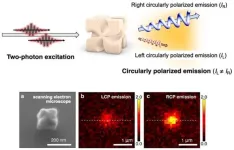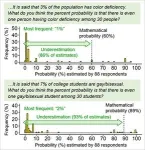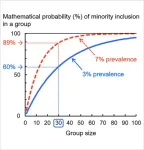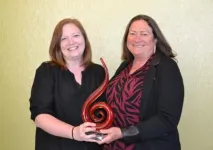(Press-News.org) doi.org/10.1002/adom.202400699When chiral(1) gold nanoparticles(2) are irradiated with near-infrared(3) femtosecond pulses(4), visible emission of luminescence is observed. In this study, this luminescence was found to yield high selectivity for left- or right-handed circularly polarized(5) light, depending on the chirality of the nanoparticles, with a dissymmetry factor(6) of approximately 0.7. This finding suggests the potential to elevate various applications using circularly polarized light to practical levels.
Abstruct
The research group led by Project Assistant Professor Dr. Hyo-Yong AHN, Dr. Khai Quang LE, Dr. Tetsuya NARUSHIMA, Research Assistant Professor Dr. Junsuke YAMANISHI, and Professor Dr. Hiromi OKAMOTO from the Institute for Molecular Science, and Dr. Ryeong Myeong KIM and Professor Dr. Ki Tae NAM from Seoul National University, found that the visible luminescence from chiral gold nanoparticles caused by irradiated with near-infrared femtosecond pulses depends on the chirality of the nanoparticles and yields high selectivity for left- or right-handed circularly polarized light. While the dissymmetry factor for circular polarization of luminescence in most chiral materials is typically of the order of 0.01 or below, the emission from these chiral gold nanoparticles exhibited a high dissymmetry factor of approximately 0.7.
This research was published in Advanced Optical Materials on May 30 in 2024.
Backgrounds
Chirality refers to a property of materials where their structure is not superimposable on a mirror image of itself. Light also has a chiral structure in the form of circular polarization, which can be left-handed or right-handed. Circularly polarized light has possible future applications in the fields of trace analysis of chiral substances, anti-counterfeiting, quantum information, screens or displays, and so forth.
A number of research papers on efficient generation methods for circularly polarized light have been published. One such method involves generating circular polarization through the luminescence from a material excited by light, where the wavelengths of the excitation and emitted light are different. While many studies have developed materials that generate circular polarization using this method, in most cases they provide only small dissymmetry factors (described below). That is, they produce mixed left- and right-handed circularly polarized light, with only a slight intensity difference between them.
The dissymmetry factor is an indicator of how much circular polarization is biased to be left- or right-handed. It is determined by calculating the difference between the left- and right-circularly polarized intensity divided by their average. Pure circular polarization has a dissymmetry factor (g value) of ±2, and linear or unpolarized light has a g value of 0. Most traditional circularly polarized light-emitting materials have a dissymmetry factor of the order of 0.01 or less, and thus it has been difficult to reliably identify the generated circularly polarized light.
Achievements
The research group focused on the visible luminescence generated when chiral gold nanoparticles are irradiated with near-infrared femtosecond pulses. Although the incident light was non-chiral and linearly polarized, the emitted light was found to be highly selective for either left- or right-handed circular polarization. The dissymmetry factor was approximately 0.7, indicating a significantly higher degree of circular polarization compared to many other circularly polarized light-emitting materials used in previous studies (the dissymmetry factors are typically of the order of 0.01 or less). Additionally, theoretical calculations and analyses revealed the mechanism for this high selectivity.
Perspectives
This research demonstrates that chiral structured metal nanoparticles are useful materials for generating circularly polarized light, biased to left- or right-handed polarization. Understanding this mechanism also provides guidelines for more efficient circular polarization generation. This work paves the way for developing materials and devices that can efficiently generate circular polarization at various wavelengths and applications in anti-counterfeiting and quantum information using circularly polarized light.
Technical Terms
(1) Chiral, Chirality: When the structure of a matter or a physical phenomenon is not superposable on its mirror image, the structure or the phenomenon is chiral. The property when a matter or a phenomenon is unable to be superimposed with its mirror image is called chirality. For example, the right hand and the left hand are mirror copies of each other, but these structures are not superposable. The right and left hand are thus chiral structures.
(2) Nanoparticles: Small particles with sizes of nanometer scale. Nanoparticles that are sufficiently smaller than half the wavelength of light can be exerted by the optical gradient force.
(3) Near-infrared region: Light with a slightly longer wavelength than visible light (in the range of approximately 0.75μm to 2μm).
(4) Femtosecond pulse light: Flashes with an extremely short duration of about ten trillionths of a second, obtained from special lasers. The light source used here produces pulses at a rate of about 80 million times per second.
(5) Circular polarization: When the electric and magnetic fields of light circularly rotate in a plane perpendicular to the direction of propagation, the light is called circularly polarized light. There are two rotational directions, clockwise and counter-clockwise, which are called right- and left-circular polarizations, respectively. As the electric and magnetic fields associated with right- and left-circularly polarized light are of spiral structures that are mirror images to each other, circularly polarized light is chiral.
(6) Dissymmetry factor: A numerical indicator of how much circular polarization is biased to be left- or right-handed (how pure the left- or right-handed circular polarization is), defined as g = 2(IL-IR)/(IL+IR). Here, IL and IR are the intensities of the left- and right-handed circularly polarized components, respectively. Pure left-handed circular polarization has g=2, pure right-handed circular polarization has g=-2, and linear or unpolarized light has g=0.
Information of the paper
Authors: Hyo-Yong Ahn, Khai Q. Le, Tetsuya Narushima, Junsuke Yamanishi, Ryeong Myeong Kim, Ki Tae Nam, Hiromi Okamoto
Journal Name: Advanced Optical Materials
Journal Title: “Highly Chiral Light Emission Using Plasmonic Helicoid Nanoparticles”
DOI: 10.1002/adom.202400699
Research Group
Institute for Molecular Science
Seoul National University
Financial Supports
This work was supported in part by Grants-in Aid for Scientific Research (JP21H04641, JP21K18884, JP16H06505, and JP22H05135) from JSPS and MEXT.
Contact Person
Hiromi OKAMOTO
Professor, Center for Mesoscopic Sciences, Institute for Molecular Science / Professor, The Graduate University for Advanced Studies, SOKENDAI
E-mail: aho_at_ims.ac.jp (Please replace the "_at_" with @)
Hyo-Yong AHN
Project Assistant Professor, Center for Novel Science Initiatives, National Institutes of Natural Sciences; Center for Mesoscopic Sciences, Institute for Molecular Science
Phone: +81-564-55-7320 / Fax: +81-564-54-2254
END
Gold nanoparticles that selectively emit left-/right-handed light
2024-06-05
ELSE PRESS RELEASES FROM THIS DATE:
New AI algorithm detects rare epileptic seizures
2024-06-05
More than 3.4 million people in the US and 65 million people worldwide have epilepsy, a neurological disorder that affects the nervous system and causes seizures. One in 26 people will develop epilepsy at some point in their lives, and 1 out of 1000 people with epilepsy die from unexpected deaths each year.
Like many conditions, epilepsy treatment starts with early detection. The World Health Organization estimates that 70% of people with epilepsy could live seizure-free if adequately diagnosed and treated.
Over the years, ...
People underestimate the probability of including at least one minority member in a group
2024-06-05
Niigata, Japan - Human society includes various minority groups. However, it is often difficult to know whether someone is a minority member simply by looking at the person, as minority traits may not be visually apparent (e.g., sexual orientation, color vision deficiency). In addition, minorities may hide their minority traits or identities. Consequently, we may have been unaware of the presence of minorities in daily life. Probabilistic thinking is critical in such uncertain situations. The people with whom we interact in our daily lives are typically a group of several dozen individuals (e.g., a school class). How do we judge the probability of including at least one minority ...
Celebrate Pride Month by learning CPR. The life you save may be someone you love
2024-06-05
DALLAS, June 4, 2024 — According to the American Heart Association, when someone suffers a cardiac arrest, immediate cardiopulmonary resuscitation (CPR) is critical and can double or triple a person’s chance of survival. More than 350,000 out-of-hospital cardiac arrests occur in the United States each year. Of those, 90% will not survive, according to the Association, which is working to turn more bystanders into lifesavers who can use CPR in an emergency. The American Heart Association, celebrating one hundred years of lifesaving service as a global ...
Dr. Erin Belval honored for exemplary fire science research
2024-06-05
FORT COLLINS, Colo., June 4, 2024 — Dr. Erin Belval, a research forester at the USDA Forest Service Rocky Mountain Research Station, was awarded the Early Career Scientist Award in Fire Science from the International Association of Wildland Fire (IAWF). She received the honor last month at the 2024 International Wildland Fire Conference in Boise, Idaho.
The award recognizes promising early-career professionals who demonstrate outstanding ability in any field of wildland fire science. Belval was nominated by colleagues and peers for her outstanding contributions.
“The award is particularly meaningful because ...
A novel approach to tracking conservation reveals more areas may be conserved than currently accounted for
2024-06-05
(Santa Barbara, Calif.) — Thirty by thirty. It’s an ambitious answer to growing calls for protecting more of our planet’s surface. The goal is to conserve 30% of the Earth’s oceans, lands and freshwaters by 2030. While this may seem a lofty aim, the diversity and coverage of conservation areas today might be greater than what’s currently recognized by global tracking systems.
An international team of conservation researchers and practitioners, led by scientists at UC Santa Barbara and The Nature Conservancy, has developed an inclusive inventory approach for tracking ...
Commonly used alcohol-based mouthwash brand disrupts the balance of your oral microbiome, scientists say
2024-06-05
SUMMARY
Researchers have identified a significant change in composition and abundance of bacteria in study participants’ oral microbiomes after using a popular brand of alcohol-based mouthwash.
The oral microbiome is the community of bacteria that live in the mouth, they help us digest our food and keep our mouth healthy.
Researchers found that two species of opportunistic bacteria were significantly more abundant in the mouth after daily use of the alcohol-based mouthwash, Fusobacterium nucleatum and Streptococcus anginosus. ...
Injury prediction rule could decrease radiographic imaging exposure in children, study shows
2024-06-05
(COLUMBUS, Ohio) – While cervical spine injuries (CSI) are uncommon in children, they can be potentially devastating, resulting in quadriplegia – paralysis below the neck affecting both arms and both legs. Detecting CSIs in a clinical setting often requires imaging such as X-rays and computed tomography (CT) scans, both of which expose children to radiation, which can cause other health issues over time.
In a study published today in The Lancet Child & Adolescent Health, researchers in the Pediatric Emergency Care Applied Research Network (PECARN) – led by Julie Leonard, MD, MPH at Nationwide Children’s Hospital –created a highly accurate ...
Rate of global warming caused by humans at an all-time high say scientists
2024-06-05
University of Leeds press release
UNDER EMBARGO UNTIL 00.01 UK BST, 5 JUNE 2024 (19.01 US ET, 4 JUNE 2024)
The second annual Indicators of Global Climate Change report, which is led by the University of Leeds, reveals that human-induced warming has risen to 1.19 °C over the past decade (2014-2023) – an increase from the 1.14 °C seen in 2013-2022 (set out in last year’s report).
Looking at 2023 in isolation, warming caused by human activity reached 1.3 °C. This ...
Housing associations can be “change makers” for communities, says whitepaper
2024-06-05
Housing associations are being urged to step out of their traditional role to deliver change in deprived areas and help people into work or entrepreneurship.
The call comes in a whitepaper published today by the University of East Anglia (UEA), written in response to how the UK levelling up policy agenda has so far failed to deliver results for constituents in the communities it is designed to help.
It follows a £10.8M Increase Valorisation Sociale (INCREASE VS) project, which showed how housing associations can go ...
Women’s mental agility is better when they’re on their period
2024-06-05
Participants reacted quicker and made fewer errors during menstruation, despite believing their performance would be worse, according to new research from UCL and the Institute of Sport, Exercise & Health (ISEH).
The study, published in Neuropsychologia, is the first to assess sport-related cognition during the menstrual cycle and is part of a larger research project supported by the FIFA Research Scholarship.
The findings act as a proof-of-principle that specific types of cognition fluctuate throughout the ...



